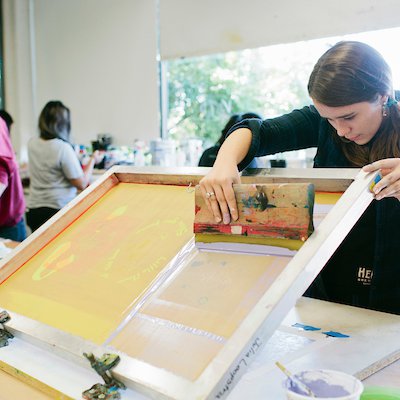The Essential Guide to Recognizing Screen Printing and Its Versatile Uses
Screen printing has an abundant history that dates back to old times, evolving right into an advanced technique made use of across various sectors today. This overview checks out the complexities of the screen printing process, outlining its applications in style, advertising, and home style - 10:9 Design Screen Printing. Recognizing these basics can open creative possibility for both artistic and commercial jobs. The complying with sections will reveal important suggestions and methods to enhance one's screen printing undertakings
The History of Screen Printing
Screen printing has roots that trace back centuries, its advancement mirrors the artistic and technological developments of different societies. Coming from in old China, the strategy was originally utilized for embellishing textiles and later spread to Japan, where it ended up being important to Ukiyo-e woodblock printing. The method shifted to Europe in the 18th century, where it gained appeal amongst craftsmens and business printers. The development of image solution in the 20th century reinvented screen printing, enabling even more complex styles and greater efficiency. Musicians like Andy Warhol additionally thrust its appeal, utilizing the medium to create legendary jobs that mixed commercialism and art. By the late 20th century, screen printing had developed itself as a functional method, utilized in vogue, advertising, and fine art. Today, it proceeds to evolve, integrating electronic innovation and increasing its applications throughout numerous sectors.
The Screen Printing Refine Explained
Screen printing changes creative visions right into concrete styles with a series of exact actions. Initially, a picture is produced and afterwards moved onto a screen, normally constructed from fine mesh material stretched over a frame. A light-sensitive emulsion is used to the screen, which is subjected to light, solidifying in areas not covered by the image. After washing out the unhardened solution, a pattern is developed.
Next, the screen is positioned over the substrate, whether it be material, paper, or another material. Ink is after that pressed through the open locations of the pattern utilizing a squeegee, transferring the design onto the substratum below. This process can be duplicated for multiple shades, requiring separate displays for each tone. Lastly, the printed product is cured making use of heat to guarantee the ink adheres correctly, resulting in a long lasting, lively design all set for usage.
Kinds of Screen Printing Techniques

In addition, specialty methods, such as discharge screen printing, eliminate color from the fabric to create softer prints, while foil screen printing applies metallic foil to accomplish a glossy surface (10:9 Design Screen Printing Texas). Each strategy provides unique characteristics, accommodating numerous imaginative demands and manufacturing ranges, ultimately expanding the opportunities within the screen printing domain
Applications of Screen Printing in Different Industries
Furthermore, the signage and marketing fields use screen printing for producing distinctive display screens and banners. This method permits vibrant colors and complex styles that catch focus. In electronic devices, screen printing is used for using conductive inks to motherboard, vital for element connections. Additionally, the home decoration sector embraces screen printing to create distinctive designs on textiles and wall surface art. In general, screen printing serves as an important tool throughout varied fields, boosting products with customized and visually enticing graphics.
Tips for Effective Screen Printing Projects
While embarking on a screen printing project, browse around this site careful interest to information can substantially enhance the final end result. First, picking high-grade materials is vital; this consists of the screen, inks, and substrates. Using suitable mesh counts can influence ink deposition and information resolution. Preparation is just as vital; complete cleansing of screens and proper exposure times ensure crisp prints.
Next, accurate enrollment is critical for multi-color prints. Utilizing placement devices can assist achieve precise layering. Additionally, screening prints on scrap products prior to production helps recognize possible problems without losing resources.

Frequently Asked Questions
What Materials Are Best for Screen Printing on Fabric?
Cotton and polyester blends are optimal for screen printing on textile due to their toughness and ink absorption. Furthermore, specialized fabrics like silk or canvas can create special appearances and finishes, improving the overall design top quality.
Exactly how Do I Clean and Maintain Screen Printing Tools?
To clean up and maintain screen printing equipment, one should frequently wash displays with proper solvents, inspect mops for wear, oil relocating parts, and shop all products in a dry, dust-free setting to extend their lifespan.
What Are the Ecological Impacts of Screen Printing?
Screen printing can have considerable environmental influences, consisting of chemical waste from solvents and inks, water usage during cleansing processes, and power consumption. Lasting practices and green materials are essential for lessening these adverse effects.
Can Screen Printing Be Done in the house Effectively?
Screen printing can be successfully done at home with the appropriate materials and methods. Enthusiasts can develop quality prints, though success depends upon their ability degree, equipment, and understanding of the procedure entailed.
What Are the Costs Related To Beginning a Display Printing Business?

Beginning a screen printing business involves costs for equipment, products, and workspace. Initial expenses typically range from a couple of hundred to several thousand bucks, relying on the range, top quality of equipment, and preferred production capacity.
Screen printing has a rich history that dates back to ancient times, advancing right into an advanced method utilized across various industries today. Another technique, rotary screen printing, uses round displays, helping with constant printing on material check this site out rolls, thereby enhancing effectiveness for large-scale manufacturings. Furthermore, specialty techniques, such as discharge screen printing, get rid of color from the material to create softer prints, while aluminum foil screen printing applies metal foil to accomplish a shiny coating. In the style industry, screen printing is widely made use of to produce vivid styles on clothing, his response enabling brand names to showcase their special styles. Cotton and polyester blends are excellent for screen printing on material due to their sturdiness and ink absorption.